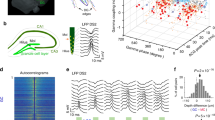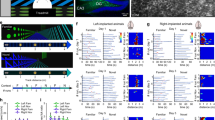Abstract
We follow up on a suggestion by Rolls and co-workers, that the effects of competitive learning should be assessed on the shape and number of spatial fields that dentate gyrus (DG) granule cells may form when receiving input from medial entorhinal cortex (mEC) grid units. We consider a simple non-dynamical model where DG units are described by a threshold-linear transfer function, and receive feedforward inputs from 1,000 mEC model grid units of various spacing, orientation and spatial phase. Feedforward weights are updated according to a Hebbian rule as the virtual rodent follows a long simulated trajectory through a single environment. Dentate activity is constrained to be very sparse. We find that indeed competitive Hebbian learning tends to result in a few active DG units with a single place field each, rounded in shape and made larger by iterative weight changes. These effects are more pronounced when produced with thousands of DG units and inputs per DG unit, which the realistic system has available, than with fewer units and inputs, in which case several DG units persists with multiple fields. The emergence of single-field units with learning is in contrast, however, to recent data indicating that most active DG units do have multiple fields. We show how multiple irregularly arranged fields can be produced by the addition of non-space selective lateral entorhinal cortex (lEC) units, which are modelled as simply providing an additional effective input specific to each DG unit. The mean number of such multiple DG fields is enhanced, in particular, when lEC and mEC inputs have overall similar variance across DG units. Finally, we show that in a restricted environment the mean size of the fields is unaltered, while their mean number is scaled down with the area of the environment.





Similar content being viewed by others
Notes
Note that the exact type of λ sampling is not essential. What is important is that many different spacings, as well as orientations and spatial phases, are sampled. We also run simulations with the same sampling of spacings and phases but a unique orientation of the grids, and results were quite different, as that orientation remained quite salient in the nearly periodic responses of many of the DG units (not shown).
The positive Poisson distribution is defined as \(p(k)={\frac{e^{-\lambda}\lambda^k}{k!(1-e^{-\lambda})}}, k=1,2,\cdots.\) The positive discrete exponential distribution is defined as \(p(k)=e^{-\lambda k}(e^{\lambda}-1), k=1,2,\cdots.\) The maximum likelihood estimation of the parameter λ is fitted according to the actual distribution of the peaks.
References
Aimone J, Wiles J, Gage F (2006) Potential role for adult neurogenesis in the encoding of time in new memories. Nat Neurosci 9:723–727
Amaral D, Ishizuka N, Claiborne B (1990) Neurons, numbers and the hippocampal network. Prog Brain Res 83:1–11
Burgess N, Barry C, O’Keefe J (2007) An oscillatory interference model of grid cell firing. Hippocampus 17(9):901–812
Chawla M, Guzowski J, Ramirez-Amaya V, Lipa P, Hoffman K, Marriott L, Worley P, McNaughton B, Barnes C (2005) Sparse, environmentally selective expression of arc rna in the upper blade of the rodent fascia dentata by brief spatial experience. Hippocampus 15:579–586
Franzius M, Sprekeler H, Wiskott L (2007a) Slowness and sparseness lead to place, head-direction, and spatial-view cells. PLoS Comput Biol 3:1605–1622
Franzius M, Vollgraf R, Wiskott L (2007b) From grids to places. J Comput Neurosci 22:297–299
Fyhn M, Molden S, Witter M, Moser E, Moser M-B (2004) Spatial representation in the entorhinal cortex. Science 305:1258–1264
Fyhn M, Hafting T, Treves A, Moser M-B, Moser E (2007) Hippocampal remapping and grid realignment in entorhinal cortex. Nature 446:190–194
Hafting T, Fyhn M, Molden S, Moser M-B, Moser E (2005) Microstructure of a spatial map in the entorhinal cortex. Nature 436:801–806
Hargreaves E, Rao G, Lee I, Knierim J (2005) Major dissociation between medial and lateral entorhinal input to the dorsal hippocampus. Science 308:1792–1794
Hayman R, Jeffery K (2008) How heterogeneous place cell responding arises from homogeneous grids—a contextual gating hypothesis. Hippocampus 18:1301–1313
Hebb D (1949) The organization of behavior: a neuropsychological theory. New York: Wiley
Ho S, Hori E, Kobayashi T, Umeno K, Tran A, Ono T, Nishijo H (2008) Hippocampal place cell activity during chasing of a moving object associated with reward in rats. Neuroscience 154:254–270
Igarashi J, Hayashi H, Tateno K (2007) Theta phase coding in a network model of the entorhinal cortex layer II with entorhinal-hippocampal loop connections. Cogn Neurodyn 1:169–184
Jung M, McNaughton B (1993) Spatial selectivity of unit activity in the hippocampal granular layer. Hippocampu 3:165–182
Kropff E, Treves A (2008) The emergence of grid cells: intelligent design or just adaptation? Hippocampus 18:1256–1269
Leutgeb J, Leutgeb S, Moser M-B, Moser E (2007) Pattern separation in the dentate gyrus and CA3 of the hippocampus. Science 315, 961–966
McHugh T, Jones M, Quinn J, Balthasar N, Coppari R, Elmquist J et al (2007) Dentate gyrus nmda receptors mediate rapid pattern separation in the hippocampal network. Science 319:94–99
Molter C, Yamaguchi Y (2008) Entorhinal theta phase precession sculpts dentate gyrus place fields. Hippocampus 18:919–930
O’Keefe J (1976) Place units in the hippocampus of the freely moving rat. Exp Neurol 51:78–109
O’Keefe J, Dostrovsky J (1971) The hippocampus as a spatial map. preliminary evidence from unit activity in the freely-moving rat. Brain Res 34:171–175
Papp G, Witter M, Treves A (2007) The CA3 network as a memory store for spatial representations. Learn Mem 14:732–744
Rolls E, Xiang J, Franco L (2005) Object, space, and object-space representations in the primate hippocampus. J Neurophysiol 94:833–844
Rolls E, Stringer S, Elliot T (2006) Entorhinal cortex grid cells can map to hippocampal place cells by competitive learning. Netw: Comput Neural Syst 15:447–465
Solstad T, Moser E, Einevoll G (2006) From grid cells to place cells: a mathematical model. Hippocampus 16:1026–1031
Suzuki W, Amaral D (2003) Perirhinal and parahippocampal cortices of the macaque monkey: cytoarchitectonic and chemoarchitectonic organisation. J Comp Neurol 463:67–91
Wagatsuma H, Yamaguchi Y (2007) Neural dynamics of the cognitive map in the hippocampus. Cogn Neurodyn 1:119–141
Acknowledgements
We are grateful for enlightening discussions to all colleagues in the Kavli Institute and in the Spacebrain EU collaboration, which has funded this work; Jill Leutgeb and Emilio Kropff have been particularly helpful with advice and access to preliminary data.
Author information
Authors and Affiliations
Corresponding author
Rights and permissions
About this article
Cite this article
Si, B., Treves, A. The role of competitive learning in the generation of DG fields from EC inputs. Cogn Neurodyn 3, 177–187 (2009). https://doi.org/10.1007/s11571-009-9079-z
Received:
Revised:
Accepted:
Published:
Issue Date:
DOI: https://doi.org/10.1007/s11571-009-9079-z




